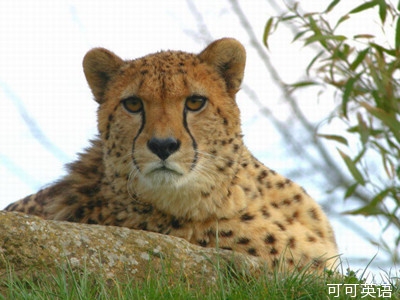科學(xué)與技術(shù)
Evolution and coat colour
進(jìn)化和表皮色彩
Well spotted
美麗涂鴉
The reason why some cats are plain and others are patterned
為何有些貓科動(dòng)物全無(wú)斑紋,而其他的則斑斑點(diǎn)點(diǎn)?
How the leopard got his spots is, famously, the subject of one of Rudyard Kipling's “Just So Stories”.
美洲豹為何滿(mǎn)身斑點(diǎn)?這是吉卜林大作《原來(lái)如此》中的一個(gè)著名問(wèn)題。
Kipling suggested they were handprints made by the leopard's human friend. More plausibly, he had an explanation for what the spots are for: to break up the animal's shape when it is hiding in the dappled light of the forest.
吉卜林認(rèn)為,那是美洲豹的人類(lèi)朋友們留下的手印。他更靠譜的解釋是,當(dāng)美洲豹藏身在樹(shù)叢的斑駁光影之中,斑點(diǎn)有助于讓它們“隱去”形跡。
 These days, the human-handprint theory of the leopard's spots has fallen out of favour.
These days, the human-handprint theory of the leopard's spots has fallen out of favour.
最近,美洲豹斑點(diǎn)的手印理論已不合口味。
Instead, a more prosaic idea has gained ground, based on what is known as reaction-diffusion pattern formation, in which chemicals that trigger the differentiation of cells in an embryo interact with one another to produce patterns that are then reflected in the fates of nearby cells.
取而代之并漸為人知的是一種更乏味的觀點(diǎn):斑點(diǎn)產(chǎn)生于“反應(yīng)-擴(kuò)散”的圖案形成過(guò)程,其中,胚胎細(xì)胞分化由化學(xué)反應(yīng)引發(fā),各類(lèi)化學(xué)反應(yīng)之間又發(fā)生作用,其作用模式最后在表皮細(xì)胞的發(fā)育中表現(xiàn)出來(lái)。
But that, too, has its difficulties. Just how much a process like this can be shaped by natural selection is unclear.
但這一說(shuō)也有其困難,它在多大程度上收到自然選擇的影響,目前尚不清楚。
Reaction-diffusion patterns which can be created in a laboratory using standard reagents are simple and deterministic.
反應(yīng)-擴(kuò)散模式可在實(shí)驗(yàn)室用標(biāo)準(zhǔn)試劑產(chǎn)生簡(jiǎn)潔而又有說(shuō)服力。
That simple reactions of this sort sometimes result in cryptic patterns could be a coincidence.
這類(lèi)偶爾引發(fā)神奇圖案的簡(jiǎn)單反應(yīng)純粹是巧合。
Nevertheless, the details of the patterns produced vary, according to things like how rapidly the chemicals diffuse.
不過(guò),圖案產(chǎn)生的細(xì)節(jié)各各不同,依據(jù)諸如擴(kuò)散速度等情形而有差別。
That could be selected. Different cats do, indeed, have different patterns.
這就可加以選擇。確實(shí),不同的貓科動(dòng)物有不同圖案。
So researchers at the University of Bristol, led by William Allen, have been deconstructing these patterns, trying to match the elements to cats' habits and habitats, and thus show whether the patterns are evolving.
因此,在威廉姆﹒艾倫的帶領(lǐng)下,布里斯托大學(xué)的研究者正在分解這些圖案,并嘗試把圖案要素同貓科動(dòng)物的習(xí)性與棲息地匹配起來(lái),以發(fā)現(xiàn)圖案是否會(huì)發(fā)生進(jìn)化。
They published their results this week in the Proceedings of the Royal Society.
本周他們?cè)凇痘始覍W(xué)會(huì)學(xué)報(bào)》上發(fā)表了研究結(jié)果。
The reaction-diffusion process can be mimicked by a computer, and the program's parameters manipulated to produce patterns matching those of cat coats.
反應(yīng)-擴(kuò)散過(guò)程可以用計(jì)算機(jī)加以模擬,對(duì)程序參數(shù)也可加控制,以產(chǎn)生同貓科動(dòng)物外表匹配的圖案。
That, the researchers hoped, might help illuminate what is going on.
研究者希望借此搞清楚到底發(fā)生了什么。
They trawled the world wide web for pictures of wild cats, found the best six for each of 37 species, and roped in a group of human volunteers to choose which of the program's outputs were most similar to real coats.
他們?cè)诨ヂ?lián)網(wǎng)上搜羅野生貓科動(dòng)物的圖片,為37個(gè)貓科物種的每一種都準(zhǔn)備了最佳的6張照片,并說(shuō)服一批人類(lèi)志愿者來(lái)判定:哪個(gè)程序的輸出結(jié)果和真實(shí)的外表最為相似。
The patterns produced had five parameters: how plain they were, how irregular, how complex, how big the spots were and whether the pattern had a perceptible direction to it.
為產(chǎn)生圖案設(shè)置了5個(gè)參數(shù):斑點(diǎn)的有無(wú)程度、規(guī)則程度、復(fù)雜程度、大小程度、是否有明顯的生長(zhǎng)位置。
The volunteers' judgments about which artificial patterns best matched which natural ones were almost perfectly consistent.
志愿者關(guān)于人工圖案與自然圖案匹配程度的判斷幾乎完美的一致。
That allowed Mr Allen to assess which parameters contribute to each species's pattern, and thus which are correlated with behaviour.
這使艾倫先生可以推斷哪個(gè)參數(shù)對(duì)物種的圖案起了影響,從而進(jìn)一步同物種行為聯(lián)系起來(lái)。
The biggest distinction—no surprise, but nice to confirm—is that spotted cats are forest cats and plain ones prefer open countryside.
最大的區(qū)別發(fā)現(xiàn)本身并不出人意料,但推理非常嚴(yán)密是:有斑點(diǎn)的貓科動(dòng)物生活在叢林中,沒(méi)有斑點(diǎn)的更偏好生活在開(kāi)闊的平原地帶。
In that, Kipling was right.
在這點(diǎn)上,吉卜林是對(duì)的。
An analysis based on the relationship between the species, though, shows that evolutionary lines can swap from spots to no spots, and vice versa, as the habitat dictates.
基于物種關(guān)系的一個(gè)分析表明,進(jìn)化路線有時(shí)是從有斑點(diǎn)到無(wú)斑點(diǎn),有時(shí)又反過(guò)來(lái),這取決于棲息地在哪里。
Moreover, the more a species prefers the forest, the more irregular the pattern it sports, and the more complex.
并且,如果一個(gè)物種越是喜歡叢林生活,圖案就越是不規(guī)則,越加復(fù)雜對(duì)大小和圖案生長(zhǎng)位置沒(méi)有影響。
Size and direction have no effect.Even among forest-dwellers there are differences.
即使叢林物種之間也不一樣。
Those that tend to spend their time actually in trees, as opposed to wandering around on the ground between them, have more irregular and complex patterns.
與那些喜歡呆在地上的相比,更多時(shí)間呆在樹(shù)上的種群,其圖案就更不規(guī)則,更加復(fù)雜。
And, crucially, there is no relationship between a cat's pattern and how sociable it is.
并且,重要的是在貓科動(dòng)物的圖案和社群習(xí)性之間沒(méi)有關(guān)聯(lián)。
That knocks on the head an alternative explanation for coat patterns, namely that spots are some form of signal between animals of the same species.
這對(duì)關(guān)于表皮圖案的另一理論解釋是當(dāng)頭一擊,此種解釋認(rèn)為斑點(diǎn)是同一動(dòng)物種群的共有標(biāo)記形式。
Mr Allen and his colleagues made one other observation. Some species of cat regularly produce melanic forms—the so-called black panther actually a melanic jaguar being the most familiar.
艾倫先生及其同事還作了其他的觀察。某些貓科動(dòng)物會(huì)周期性變成黑色——例如大家熟悉的黑豹實(shí)際上是黑色的美洲虎。
The data seem to rule out one obvious explanation for melanism: the idea that black cats, with their unusual appearance, have more success hunting because their prey are not keeping an eye out for predators that look like them.
這一觀察似乎也排除了“黑變論”的解釋。這種說(shuō)法是,黑色貓科動(dòng)物因其不同尋常的外表,而在捕獵方面非常成功,因?yàn)樗鼈儫o(wú)須留神被獵物看見(jiàn)。
Melanic forms, though, are particularly prevalent in species with complicated lives—those that inhabit a range of habitats, are active both day and night, and move between the ground and the trees.
可是,黑色外表為各種復(fù)雜形式的物種所有,它們棲息在不同地帶、有白天活動(dòng)的也有黑夜活動(dòng)的、有在地面生存的也有在樹(shù)上生存的。
What advantage melanism brings in these circumstances is obscure.
在這些環(huán)境中表皮黑化到底有什么優(yōu)勢(shì)似乎模糊不清。
One for Kipling, perhaps. “How the jaguar got his melanocytes.”
這問(wèn)題可能要交給吉卜林了:“美洲虎為何是黑色?”
 These days, the human-handprint theory of the leopard's spots has fallen out of favour.
These days, the human-handprint theory of the leopard's spots has fallen out of favour.
 These days, the human-handprint theory of the leopard's spots has fallen out of favour.
These days, the human-handprint theory of the leopard's spots has fallen out of favour.